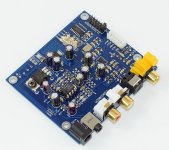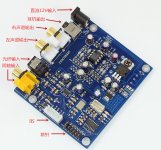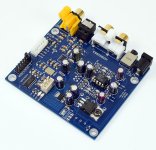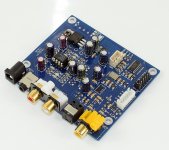Hi folks
I'm in the early stages of designing and building a DIY DAC using an ES9038 board.
I am using the chassis of a Cambridge Audio CD player stripped of it's guts but retaining the transformer and small PCB connected to it that hold a fuse and the power switch.
My understanding is that I could just run the DAC board directly from this transformer as the DAC board has a power supply section, but it is far better to bypass this and use a completely separate regulated power supply.
I have been looking at the plethora of regulated power supply stages available on ebay and it seems to me that most of them are very simple and consist of nothing more than a rectifier and two banks of large electrolytic capacitors with the last electrolytic in each bank having a smaller polystyrene cap in parallel.
So, what I'm wondering is this - could I simply build my own PSU section using a bridge rectifier, a load of big electrolytic caps and a couple of polystyrene caps?
Are there plans available for such a PSU?
Most of the variation in the available PSU stages seems to be in the number and size of capacitors, the cheapest having just 2 caps, then versions with 4, 6, 8, 10 or more caps are available. Is it a case of the more caps the better? Are a few big caps better than a bunch of smaller ones?
One more question - rectifiers, there seems to be three options - a four-pin bridge rectifier, a pair of schottky diodes or a tube/valve rectifier (6Z4 type?).
What are the pros and cons of these different types of rectifier? The bridge rectifier is probably the simplest, you can buy cheap kits to build a rectifier from a pair of schottkys and the tube/valve rectifier boards are available assembled, so all three solutions are fairly simple to obtain, they difference is mostly in cost - a bridge rectifier is a 0.99ukp item, the dual Schottky kits are about 7ukp and the tube rectifiers are about 15ukp assembled inc. Chinese tubes. I realise the tube solution requires more than one AC feed, the primary seems to be 6.3v, the secondary is higher (for the heaters of the tubes?) but how high is it, will it require a dedicated transformer to provide a suitable high voltage?
Bridge rectifier:
Single Phase Diode Bridge Rectifier 50A 1000V KBPC5010 New C8M4 4894462378748 | eBay
Dual Schottkys kit:
30A Class A Amplifier Power Supply Rectifier Filter Kits Schottky Rectifier DIY | eBay
Tube rectifier:
1piece Dual 6Z4 tubes DIY Rectifier PCB Assembled | eBay
I'm in the early stages of designing and building a DIY DAC using an ES9038 board.
I am using the chassis of a Cambridge Audio CD player stripped of it's guts but retaining the transformer and small PCB connected to it that hold a fuse and the power switch.
My understanding is that I could just run the DAC board directly from this transformer as the DAC board has a power supply section, but it is far better to bypass this and use a completely separate regulated power supply.
I have been looking at the plethora of regulated power supply stages available on ebay and it seems to me that most of them are very simple and consist of nothing more than a rectifier and two banks of large electrolytic capacitors with the last electrolytic in each bank having a smaller polystyrene cap in parallel.
So, what I'm wondering is this - could I simply build my own PSU section using a bridge rectifier, a load of big electrolytic caps and a couple of polystyrene caps?
Are there plans available for such a PSU?
Most of the variation in the available PSU stages seems to be in the number and size of capacitors, the cheapest having just 2 caps, then versions with 4, 6, 8, 10 or more caps are available. Is it a case of the more caps the better? Are a few big caps better than a bunch of smaller ones?
One more question - rectifiers, there seems to be three options - a four-pin bridge rectifier, a pair of schottky diodes or a tube/valve rectifier (6Z4 type?).
What are the pros and cons of these different types of rectifier? The bridge rectifier is probably the simplest, you can buy cheap kits to build a rectifier from a pair of schottkys and the tube/valve rectifier boards are available assembled, so all three solutions are fairly simple to obtain, they difference is mostly in cost - a bridge rectifier is a 0.99ukp item, the dual Schottky kits are about 7ukp and the tube rectifiers are about 15ukp assembled inc. Chinese tubes. I realise the tube solution requires more than one AC feed, the primary seems to be 6.3v, the secondary is higher (for the heaters of the tubes?) but how high is it, will it require a dedicated transformer to provide a suitable high voltage?
Bridge rectifier:
Single Phase Diode Bridge Rectifier 50A 1000V KBPC5010 New C8M4 4894462378748 | eBay
Dual Schottkys kit:
30A Class A Amplifier Power Supply Rectifier Filter Kits Schottky Rectifier DIY | eBay
Tube rectifier:
1piece Dual 6Z4 tubes DIY Rectifier PCB Assembled | eBay
Last edited:
Power supply questions MUST start from a statement of how much voltage, current, smoothing, and regulation is needed. And in this crowd, how much lily-gilding.
I dunno much about DACs but they generally need a specific *regulated* voltage. What is that voltage? How much current?
A transformer, rectifier, and cap will give a "raw DC" supply with much buzz and voltage changing with line and load. I suspect you do need a regulator.
Small silicon logic is "never" powered with a vacuum tube rectifier. Oh, I'm sure someone here does, but it isn't natural in my book.
Very likely the "best" plan is what was already IN your CD player (which had a DAC). The rectifier, cap, and regulator(s) may have been on the main board which I suppose you discarded?
I dunno much about DACs but they generally need a specific *regulated* voltage. What is that voltage? How much current?
A transformer, rectifier, and cap will give a "raw DC" supply with much buzz and voltage changing with line and load. I suspect you do need a regulator.
Small silicon logic is "never" powered with a vacuum tube rectifier. Oh, I'm sure someone here does, but it isn't natural in my book.
Very likely the "best" plan is what was already IN your CD player (which had a DAC). The rectifier, cap, and regulator(s) may have been on the main board which I suppose you discarded?
That's very useful indeed, cheers.
The blurb for the DAC says the input is DC 9-15V, the board itself is marked DC 12V. I would think that I could use the on-board voltage regulator, although if it would be a worthwhile upgrade, I'd be quite happy to add a separate VRM to clean up the DC supply.
I kept the main board from the CD player and it does indeed have a PSU section at the top end of the board, there's one 3-legged thing with a large black heatsink that I suppose is the rectifier diode, a couple of electrolytic caps and a handful of other components, I'll take some photos of it in the morning.
The blurb for the DAC says the input is DC 9-15V, the board itself is marked DC 12V. I would think that I could use the on-board voltage regulator, although if it would be a worthwhile upgrade, I'd be quite happy to add a separate VRM to clean up the DC supply.
I kept the main board from the CD player and it does indeed have a PSU section at the top end of the board, there's one 3-legged thing with a large black heatsink that I suppose is the rectifier diode, a couple of electrolytic caps and a handful of other components, I'll take some photos of it in the morning.
Attachments
Of course, much has already been written about power supplies for these boards in other threads, including a thread dedicated to this exact board. Something seems a little 'off' here. 😕
Hi Mark
The threads on this board are so long - 150+ pages in one case, that it's not easy to find specifics, if you can point to any, that would be immensely useful.
Off? I'm not understanding I'm afraid.
The threads on this board are so long - 150+ pages in one case, that it's not easy to find specifics, if you can point to any, that would be immensely useful.
Off? I'm not understanding I'm afraid.
Your DAC from the pictures has already a regulator. 7806 perhaps. So it makes sense 9V as a minimum input.
The 3 leg black thingy with heatsink You mention is a regulator or if it is an SMPS (couple of other components..) it's a dual Shottky -->|<-- diode. Measure Your CD PSU voltage. If its' within 9-15V specs, try it.
The 3 leg black thingy with heatsink You mention is a regulator or if it is an SMPS (couple of other components..) it's a dual Shottky -->|<-- diode. Measure Your CD PSU voltage. If its' within 9-15V specs, try it.
There is a linear regulator on the board to drop the externally supplied +12 to +15v down to +5v. The +5v is then used for two purposes. It provides power to a 3.3v regulator that powers all of the low voltage circuitry on the board (which is done incorrectly, but it can be improved substantially). It also provides 5v power at the I2S header for an external I2S device.
Hi Ian,
I agree. 150 pages is a lot to go through. But it sounds to me from your post that there could be other useful info in there for you. I've only been a member for 14 months and I'm still studying what's here -- and haven't asked for help yet . . .
Sometimes I wish it could be more efficient to find exactly what you need in this format, but to date, that isn't how this works. What you're asking for is the knowledge to out-engineer the work done by the original designers of the equipment (who may have spent untold hours refining it). There may be no solution here unless you're willing to sift through several threads and see what may be applicable.
In the process you'll learn a lot. And forgive me, but I think that asking the readers here to look up the requirements of a particular board and design a custom, regulated, better-than-original, power supply for it, is a lot ask -- especially when one of the 3 PSUs you're considering, is a one based on a dual-6Z4 that you found on EBay.
Do a little more legwork/homework on your own -- THEN ask for help in a post. There are a lot of smart people on here, and they're pretty much willing to share their expertise, but all the more so if the info is generally useful - i.e. less specific.
Good luck, regards,
-Rick
What's the correct pronunciation of your surname?
I agree. 150 pages is a lot to go through. But it sounds to me from your post that there could be other useful info in there for you. I've only been a member for 14 months and I'm still studying what's here -- and haven't asked for help yet . . .
Sometimes I wish it could be more efficient to find exactly what you need in this format, but to date, that isn't how this works. What you're asking for is the knowledge to out-engineer the work done by the original designers of the equipment (who may have spent untold hours refining it). There may be no solution here unless you're willing to sift through several threads and see what may be applicable.
In the process you'll learn a lot. And forgive me, but I think that asking the readers here to look up the requirements of a particular board and design a custom, regulated, better-than-original, power supply for it, is a lot ask -- especially when one of the 3 PSUs you're considering, is a one based on a dual-6Z4 that you found on EBay.
Do a little more legwork/homework on your own -- THEN ask for help in a post. There are a lot of smart people on here, and they're pretty much willing to share their expertise, but all the more so if the info is generally useful - i.e. less specific.
Good luck, regards,
-Rick
What's the correct pronunciation of your surname?
Last edited:
Sorry in advance for off topic but in connection with sorting information from diyaudio you can get a lot of the way by google searching using site:www.diyaudio.com operator. A lot better than the forum search option, which is fairly useless most of the time.
Agreed - the site search is useless. On my phone the dialogue box pops up off-screen...
I build the DA24QS DAC by Uwe Beis. It has a regulator on board (3.3V I think) but needs 12V DC PCB power.
I bought this: Accessory – iPower
Was pricey at £50, but not worth my time trying to compete with that.
Pops.
I build the DA24QS DAC by Uwe Beis. It has a regulator on board (3.3V I think) but needs 12V DC PCB power.
I bought this: Accessory – iPower
Was pricey at £50, but not worth my time trying to compete with that.
Pops.
- Status
- Not open for further replies.
- Home
- Amplifiers
- Power Supplies
- Simple Linear regulated PSU for DAC



